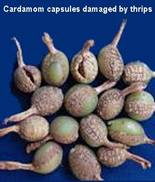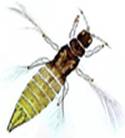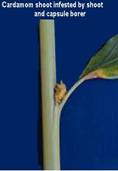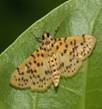Thrips: Sciothrips cardamom
| Symptoms of damage |
- Panicles become stunted
- Shedding of flowers and immature capsules thus reducing the total number of capsules formed.
- Infestation causes formation of corky encrustations on pods resulting in their malformed and shriveled condition.
- Such pods lack their fine aroma and the seeds within are also poorly developed.
|
 |
| Corky encrustations on pods |
|
| Identification of pest |
- Eggs kidney shaped lays singly in the tender part of the leaf sheath, racemes
- Adult: is minute, dark greyish brown with fringed wings.
|
 |
| Adult |
|
| Management |
- Regulate shade in thickly shaded areas.
- Spray insecticides like quinalphos 0.025% or fenthion or phosalone 0.07% during March, April, May, August and September.
|
| Note |
- For effective thrips management precautions like trashing before insecticide spray, avoiding spraying during heavy rain, using 250 to 500 ml spray fluid depending on canopy growth and proper coverage to panicles and one third portion, of plants from the base of plants are to be adhered strictly.
|
Shoot, panicle and capsule borer: Dichocrocis (Conogethes) punctiferalis
| Symptoms of damage |
- Early stage of the larva bores the unopened leaf buds and feeds on the leaf tissue.
- They also bore the panicles leading to drying up of the portion from the affected spot
- Immature capsules and feed on the young seeds inside rendering the capsules empty.
- Late stage larvae bore the pseudostem and feed the central core of the stem
- Resulting in drying of the terminal leaf and thus produce characteristic 'dead heart' symptom.
- Oozing out of frass material at the point of tunnelling is the indication for the presence of larva inside the plant parts.
- The incidence of this pest is noticed throughout the year but they occur in enormous number in four periods, December-January, March-April, May-June and September-October and their abundance synchronizes with the panicle production, fruit formation and new tiller production.
|
 |
| Corky encrustations on pods |
|
| Identification of pest |
- Egg: is pink, oval, flat and lays singly or in group on the tender part of the plant
- Larva: is long, pale greenish with a pinkish was dorsally, head and pro-thoracic shield brown in colour and body covered with minute hairs arising on wards.
- Pupa: Pupation takes place in lose silken cocoon in larval tunnel.
- Adult: is a medium sized moth; the wings are pale yellowish with black spots on the wings.
|
 |
 |
| Larva |
Adult |
|
| Management |
- During day time adult moths rest on the lower surface of the cardamom. They may be collected with insect net and killed.
- The practice of removing the tillers showing 'dead heart' symptoms should be carried with due care.
- Tillers may be removed if the attack is fresh as indicated by extrusion of frass
- The infestation by early stages of larva of this pest in emerging panicle, immature capsule and leaf bud can be controlled effectively with insecticide application.
- Once the late larvae bore and go deep inside the pseudostem, the chemical spray even in its higher dose becomes ineffective.
- Spraying fenthion 0.075% is effective in controlling this pest.
|
Capsule borers: Jamides sp.
| Symptoms of damage |
- Caterpillars bore and feed on the inflorescence, flower buds, flowers and capsules.
- Affected capsules become empty with a big circular hole, turn yellowish – brown which decay and drop off in the rainy season.
|
| Identification of pest |
- Eggs: Spherical, greenish white lay on the panicled flower.
- Larva: Flat, trowel shaped covered with dense hairs covering all over the body.
- Pupa: Small and brownish in colour and pupates in the debris near the panicle.
- Adult: The wings of moth are bluish with metallic lusture on the upper surface and bordered with a white thin line and black shade
|
Beetle borer: Onthophgus spp.
| Symptoms of damage |
- Larva makes the bore hole which is neat, circular tiny and at right angles to the pericarp mostly on the ventral side.
- When attack is on young immature capsules, they put forth matured appearance, decay and drop off.
- Adults beetle bores the flowers and feed on tissues
|
| Identification of pest |
- Adult: small, dark brown, cylindrical beetle with short thick erect hairs covered all over body.
- The elytra are hard and shiny.
|
| Management |
- Judicious shade regulation
- Spraying of contact insecticide viz., quinalphos @2ml or methyl parathion @2ml/lit
|
Hairy caterpillars: Eupterote cardamomi, E. canarica, E. fabia
| Symptoms of damage |
- These appear sporadically in enormous populations at intervals of several years and cause heavy damage to the foliage.
- Caterpillars are gregarious in habit and they congregate on the trunks of shade trees during day time and drop down on the cardamom plants during night time.
- They fed voraciously on leaves and defoliating the whole cardamom plants.
- Usually the damage is observed during October-December
|
| Identification of pest |
E. cardamomi
- Eggs: Dome shaped and lay on undersurface of the leaves of shade trees.
- Larva: Robust, bluish black with pale brown head, white hairs and dorsal conical tuff of hairs.
- Pupa: Pupation takes place in soil
- Adult: Large moth, pale yellow with wavy lines and a series of spots near the outer margin of wings
E. canaraica
- Eggs: Pale yellowish in colour and lays on the undersurface of the leaves of shade trees.
- Larva: Robust with red head and black ‘V’ shaped vertex border.
- Pupa: Pupation takes place in soil
- Adult: Large moth brownish yellow with two diagonal bunds and zig zag lines on wings.
E. fabia
- Larva: Robust, dark purplish brown with black head, grey tipped long hairs and red prologs.
- Pupa: Pupation takes place on dried leaves
- Adult: Large bright yellow moth with prominent black wavy lines and patches on wings.
|
| Management |
- Hairy caterpillar incidence can be checked by lopping off and burning branches of shade trees in which eggs are laid.
- Gradual elimination of shade trees favoured for egg laying will reduce the incidence.
- Caterpillars that congregate at the base of shade trees can be collected and killed.
- Moths can be attracted to light during night and by installing light traps, the moths can be collected and killed.
- Spray methyl parathion or quinalphos 3ml/lit
|
Shoot fly: Formosina flavipes
| Symptoms of damage |
- Larvae feed on the growing shoot of the young cardamom suckers
- Dead heart.
|
| Identification of pest |
- Eggs: cigar shaped and white colour and is laid in between leaf sheath and pseudostem on the whorl.
- Adult: Fly
|
| Management |
- Remove the affected shoots at ground level and destroy them.
- Spray dimethoate or quinalphos (0.05% each).
|
White flies: Dialeurodes cardamom
| Symptoms of damage |
- Nymphs and adults remain in colonies on lower leaf surface and suck the sap.
- Chlorotic patches appear on leaves,
- Gradual yellowing and get dried.
- Sooty mould development occurs due to honeydew secretion.
|
| Identification of pest |
- Nymphs: are pale greenish to greenish yellow in colour.
- Adult: with two pairs of white wings.
|
| Management |
- Spray methyl demeton or dimethoate (0.05% each) on the foliage
|
Cardamom aphid: Pentalonia nigronervosa f.Caladii
| Symptoms of damage |
- Nymphs and adults suck up plant sap.
- Colonies of aphids are seen under concealed conditions inside leaf sheaths of the older pseudo stems.
- The aphids act as a vector of the mosaic or 'Katte' virus of cardamom.
|
| Identification of pest |
- Wingless aphid is dark brown, pyriform.
- Winged aphids have wings having prominent black veins
|
| Management |
- Removal of Colocasia and other hosts in the vicinity of cardamom plantation is recommended.
- Remove partly dried and decayed pseudostems which harbour the colonies of aphids to reduce aphid population and
- Foliar spraying with phosphamidon 1 ml or dimethoate 2 ml/lit at an interval of 2 weeks in November and April gives adequate control.
|
Root grubs: Basilepta fulvicorne, Holotrichia serrata
- Among the three species B. fulvicorne is found to cause more damage in cardamom tracts.
| Symptoms of damage |
- The grubs feed on the roots in the form of irregular scraping.
- In advanced stages entire root system is found damaged resulting in drying and rotting depending on the season of attack.
- In the severely infested plants, leaves turn yellow and dry.
|
| Identification of pest |
- Grubs: Short, stout, 'C' shaped, pale white in colour.
- Adult: Beetles are shiny, metallic blue, bluish green, greenish brown or brown.
|
| Management |
- Collect the beetles using hand nets during peak period of emergence i.e., during April-May and kill them.
- Beetles can be seen resting on the leaves during day time
- The time of insecticide application is to be synchronized with the emergence of adults and egg laying.
- Applying chlorpyriphos 0.075% or phorate 2-4 g a.i./plant in May and in September-October is effective in reducing the population of grubs.
- Light raking of soil before the insecticide application is essential for effective control of root grubs.
|
Source
|





